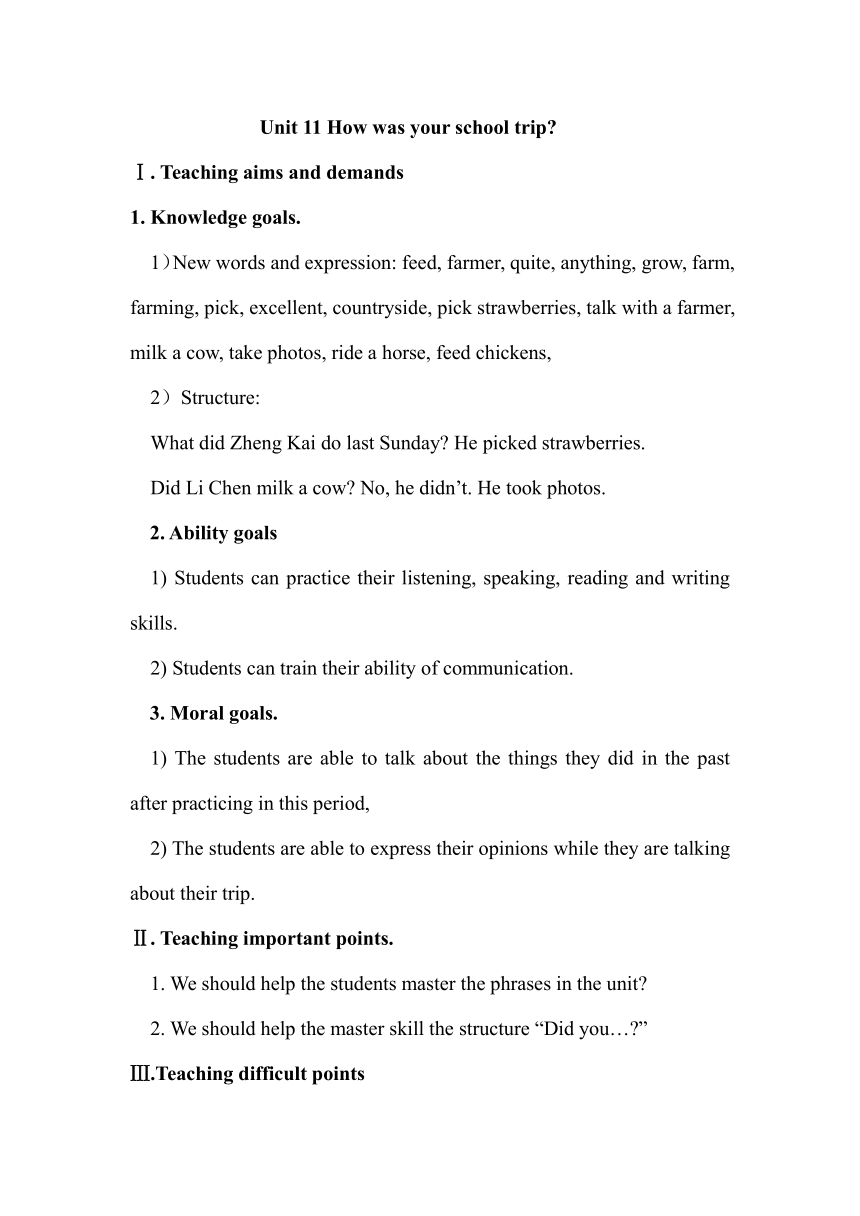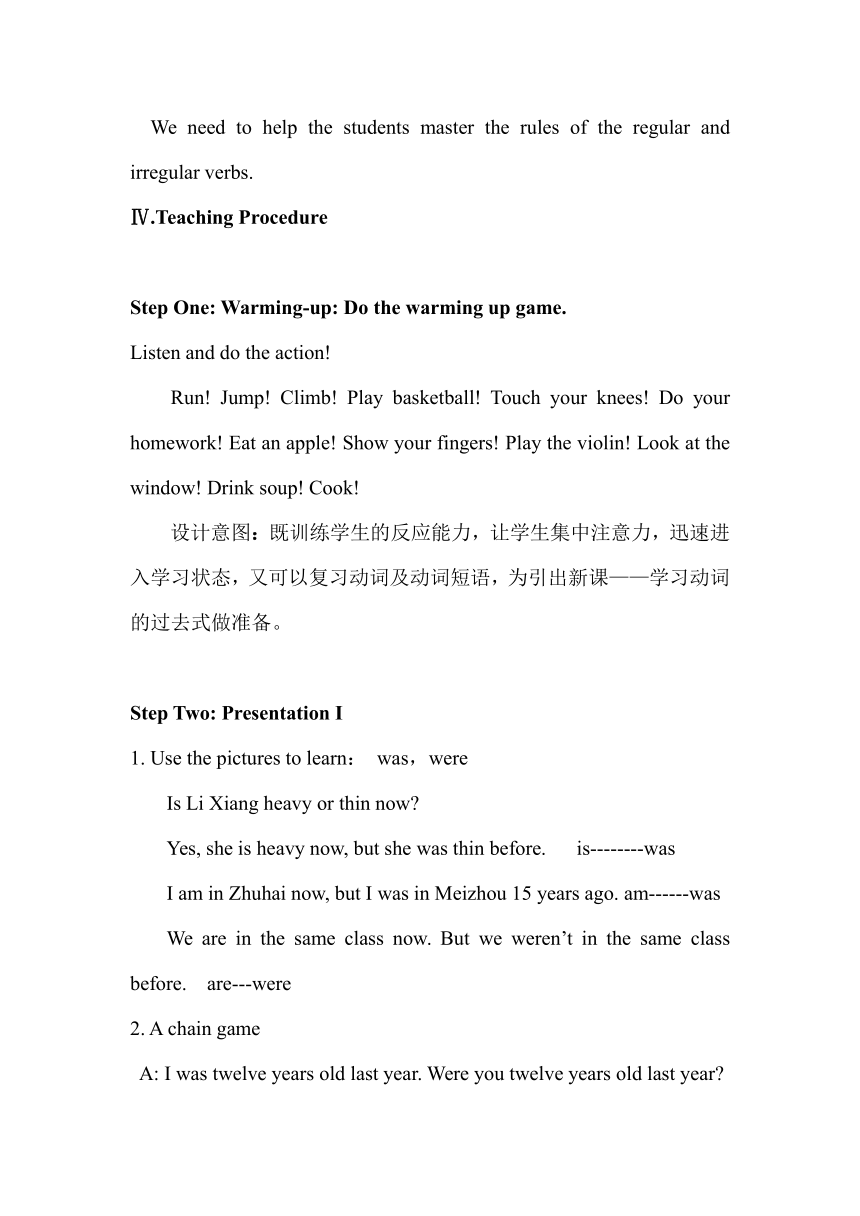人教版七年级下册 Unit11 How was your school trip? SectionA 1a-2c 教案
文档属性
| 名称 | 人教版七年级下册 Unit11 How was your school trip? SectionA 1a-2c 教案 |

|
|
| 格式 | doc | ||
| 文件大小 | 35.0KB | ||
| 资源类型 | 教案 | ||
| 版本资源 | 人教新目标(Go for it)版 | ||
| 科目 | 英语 | ||
| 更新时间 | 2022-12-16 15:44:43 | ||
图片预览


文档简介
Unit 11 How was your school trip
Ⅰ. Teaching aims and demands
1. Knowledge goals.
1)New words and expression: feed, farmer, quite, anything, grow, farm, farming, pick, excellent, countryside, pick strawberries, talk with a farmer, milk a cow, take photos, ride a horse, feed chickens,
2)Structure:
What did Zheng Kai do last Sunday He picked strawberries.
Did Li Chen milk a cow No, he didn’t. He took photos.
2. Ability goals
1) Students can practice their listening, speaking, reading and writing skills.
2) Students can train their ability of communication.
3. Moral goals.
1) The students are able to talk about the things they did in the past after practicing in this period,
2) The students are able to express their opinions while they are talking about their trip.
Ⅱ. Teaching important points.
1. We should help the students master the phrases in the unit
2. We should help the master skill the structure “Did you… ”
Ⅲ.Teaching difficult points
We need to help the students master the rules of the regular and irregular verbs.
Ⅳ.Teaching Procedure
Step One: Warming-up: Do the warming up game.
Listen and do the action!
Run! Jump! Climb! Play basketball! Touch your knees! Do your homework! Eat an apple! Show your fingers! Play the violin! Look at the window! Drink soup! Cook!
设计意图:既训练学生的反应能力,让学生集中注意力,迅速进入学习状态,又可以复习动词及动词短语,为引出新课——学习动词的过去式做准备。
Step Two: Presentation I
1. Use the pictures to learn: was,were
Is Li Xiang heavy or thin now
Yes, she is heavy now, but she was thin before. is--------was
I am in Zhuhai now, but I was in Meizhou 15 years ago. am------was
We are in the same class now. But we weren’t in the same class before. are---were
2. A chain game
A: I was twelve years old last year. Were you twelve years old last year
B: Yes, I was. / No, I wasn’t. I was ...years old last year. He/She was … years old last year. Were you … years old last year
C:…
D:…
设计意图:通过学生最熟悉的事例引出be动词is, am are的过去式was和were. 然后通过填词把刚刚学的be动词的过去式运用于实践中。最后,通过Chain Work训练他们的英语口语,让每个学生都学会运用be动词的过去式。
Step Three: Presentation II
1. Learn the drills
What did Zheng Kai do last weekend
He picked strawberries.
Did Li Chen milk a cow
Yes, he did./ No, he didn’t. He rode a horse.
2. Read the phrases and drills together.
3. Pair work to make dialogues.
设计意图:运用最受学生欢迎的节目《奔跑吧,兄弟》里的人物创设情景,导出新句型。学生学得轻松,学得快乐。
Step Four: Listening
1. 1b, listen and circle
2. 2b. Read the sentences, then listen and circle.
3. Act out the dialogue.
设计意图:加强同学们的听力训练,把新知识运用于实践中。
Step Five: Reading 2d
1. Read and answer
2. Close the books and fill in the forms.
3. Retell the story.
设计意图:先带着问题去通读全文,了解大概意思。再让学生用心记住重点知识,然后合上课本,填词。这样学生能试着运用本课新学的知识填词,又能自我判断填词是否正确。最后,抓住对话重点,复述这个故事。复述时需要学生转变人称及相应时态,可以考验学生运用知识的灵活性。
Step Six: Games
1. Lucky pete to say the phrases or sentences. You can get more points if your sentence is good.
2. Who has the best memory Compete to say the actions we did at the beginning of the class.
设计意图:第一个游戏是幸运转盘,可以检查学生对本课短语的掌握情况,又能把它拓展到其它的短语,把新旧知识联系起来,并通过激励机制,引导学生运用过去时的各种句型去造句。第二个游戏是呼应Warming up部分的,把Warming up部分的一般现在时动作用过去时去回忆并说出来,把过去时知识运用于实际操练中。
Step Seven: Summary
1.How do you tell one’s trip We need 2 how and 4 wh-
2 How: How was your trip How was the weather
4 wh-: Where did you go What did you do Who did you go with When did you go
2. Read a short passage, then try to memorize the information.
3. Pair work to check if they can get the important information of the passage.
设计意图:通过小结,明确描述一次旅程需要写清楚的要素,再通过描写去三亚旅行的文段,引导学生去挖掘文段的要素,并通过小组竞赛去加强口语训练,也激发了学生学习的动力,增加了课堂的趣味性。
Ⅰ. Teaching aims and demands
1. Knowledge goals.
1)New words and expression: feed, farmer, quite, anything, grow, farm, farming, pick, excellent, countryside, pick strawberries, talk with a farmer, milk a cow, take photos, ride a horse, feed chickens,
2)Structure:
What did Zheng Kai do last Sunday He picked strawberries.
Did Li Chen milk a cow No, he didn’t. He took photos.
2. Ability goals
1) Students can practice their listening, speaking, reading and writing skills.
2) Students can train their ability of communication.
3. Moral goals.
1) The students are able to talk about the things they did in the past after practicing in this period,
2) The students are able to express their opinions while they are talking about their trip.
Ⅱ. Teaching important points.
1. We should help the students master the phrases in the unit
2. We should help the master skill the structure “Did you… ”
Ⅲ.Teaching difficult points
We need to help the students master the rules of the regular and irregular verbs.
Ⅳ.Teaching Procedure
Step One: Warming-up: Do the warming up game.
Listen and do the action!
Run! Jump! Climb! Play basketball! Touch your knees! Do your homework! Eat an apple! Show your fingers! Play the violin! Look at the window! Drink soup! Cook!
设计意图:既训练学生的反应能力,让学生集中注意力,迅速进入学习状态,又可以复习动词及动词短语,为引出新课——学习动词的过去式做准备。
Step Two: Presentation I
1. Use the pictures to learn: was,were
Is Li Xiang heavy or thin now
Yes, she is heavy now, but she was thin before. is--------was
I am in Zhuhai now, but I was in Meizhou 15 years ago. am------was
We are in the same class now. But we weren’t in the same class before. are---were
2. A chain game
A: I was twelve years old last year. Were you twelve years old last year
B: Yes, I was. / No, I wasn’t. I was ...years old last year. He/She was … years old last year. Were you … years old last year
C:…
D:…
设计意图:通过学生最熟悉的事例引出be动词is, am are的过去式was和were. 然后通过填词把刚刚学的be动词的过去式运用于实践中。最后,通过Chain Work训练他们的英语口语,让每个学生都学会运用be动词的过去式。
Step Three: Presentation II
1. Learn the drills
What did Zheng Kai do last weekend
He picked strawberries.
Did Li Chen milk a cow
Yes, he did./ No, he didn’t. He rode a horse.
2. Read the phrases and drills together.
3. Pair work to make dialogues.
设计意图:运用最受学生欢迎的节目《奔跑吧,兄弟》里的人物创设情景,导出新句型。学生学得轻松,学得快乐。
Step Four: Listening
1. 1b, listen and circle
2. 2b. Read the sentences, then listen and circle.
3. Act out the dialogue.
设计意图:加强同学们的听力训练,把新知识运用于实践中。
Step Five: Reading 2d
1. Read and answer
2. Close the books and fill in the forms.
3. Retell the story.
设计意图:先带着问题去通读全文,了解大概意思。再让学生用心记住重点知识,然后合上课本,填词。这样学生能试着运用本课新学的知识填词,又能自我判断填词是否正确。最后,抓住对话重点,复述这个故事。复述时需要学生转变人称及相应时态,可以考验学生运用知识的灵活性。
Step Six: Games
1. Lucky pete to say the phrases or sentences. You can get more points if your sentence is good.
2. Who has the best memory Compete to say the actions we did at the beginning of the class.
设计意图:第一个游戏是幸运转盘,可以检查学生对本课短语的掌握情况,又能把它拓展到其它的短语,把新旧知识联系起来,并通过激励机制,引导学生运用过去时的各种句型去造句。第二个游戏是呼应Warming up部分的,把Warming up部分的一般现在时动作用过去时去回忆并说出来,把过去时知识运用于实际操练中。
Step Seven: Summary
1.How do you tell one’s trip We need 2 how and 4 wh-
2 How: How was your trip How was the weather
4 wh-: Where did you go What did you do Who did you go with When did you go
2. Read a short passage, then try to memorize the information.
3. Pair work to check if they can get the important information of the passage.
设计意图:通过小结,明确描述一次旅程需要写清楚的要素,再通过描写去三亚旅行的文段,引导学生去挖掘文段的要素,并通过小组竞赛去加强口语训练,也激发了学生学习的动力,增加了课堂的趣味性。
同课章节目录
- Unit 1 Can you play the guitar?
- Section A
- Section B
- Unit 2 What time do you go to school?
- Section A
- Section B
- Unit 3 How do you get to school?
- Section A
- Section B
- Unit 4 Don't eat in class.
- Section A
- Section B
- Unit 5 Why do you like pandas?
- Section A
- Section B
- Unit 6 I'm watching TV.
- Section A
- Section B
- Review of Units 1-6
- Unit 7 It's raining!
- Section A
- Section B
- Unit 8 Is there a post office near here?
- Section A
- Section B
- Unit 9 What does he look like?
- Section A
- Section B
- Unit 10 I'd like some noodles.
- Section A
- Section B
- Unit 11 How was your school trip?
- Section A
- Section B
- Unit 12 What did you do last weekend?
- Section A
- Section B
